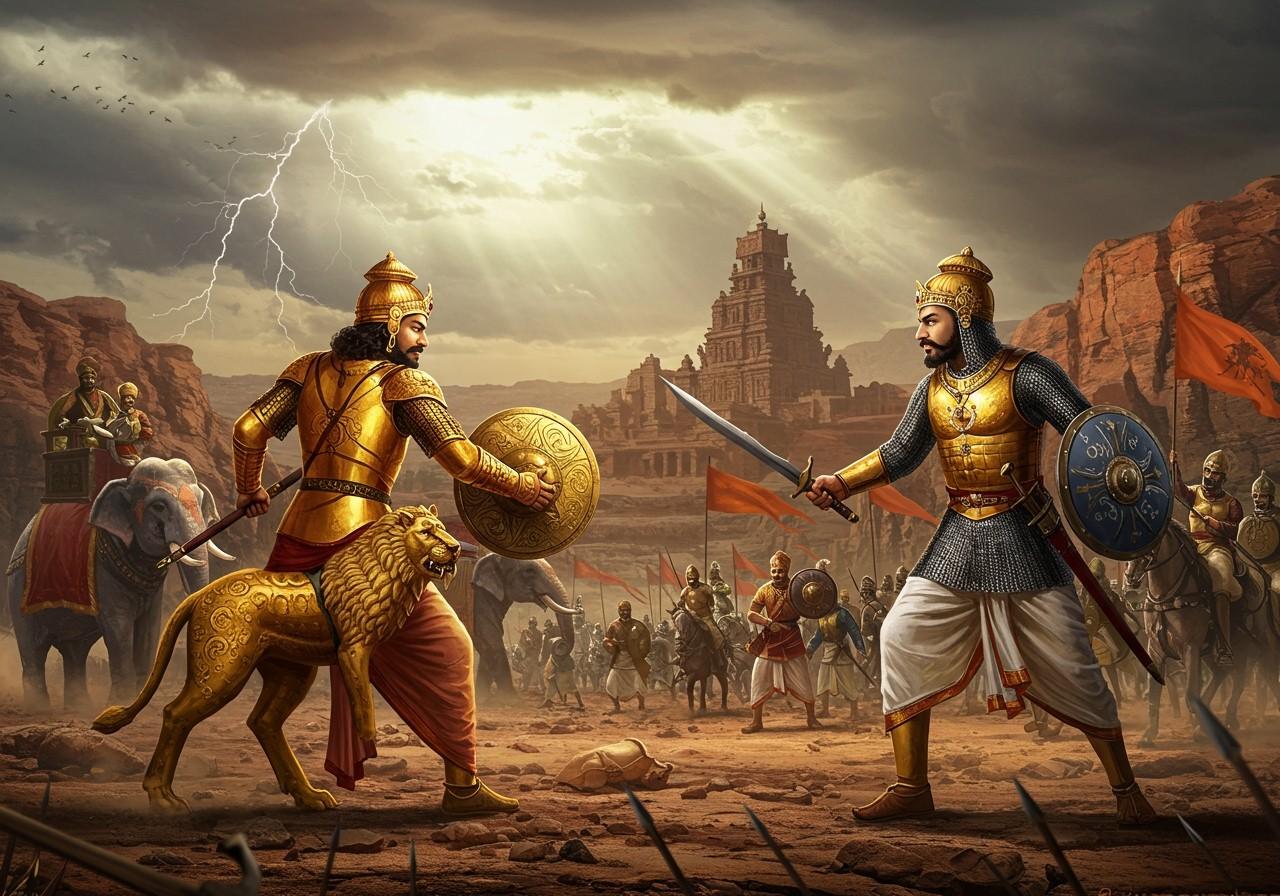
The Pallava and Chalukya dynasties, prominent powers in South India, boasted rich histories and cultural significance. Their clash, spearheaded by Narasimhavarman I and Pulakeshin II, significantly shaped the region’s trajectory. Delving into this battle unveils insights into South India’s heritage and legacy.
The Pallava Dynasty
Origins and Rulers
Emerging in the 3rd century CE, the Pallava dynasty reigned over parts of Tamil Nadu and Andhra Pradesh. Notable rulers include Simhavishnu and Mahendravarman I. Narasimhavarman I, also known as Mamalla, played a pivotal role in expanding the Pallava empire.
Cultural Contributions
The Pallavas made substantial contributions to art and architecture. Narasimhavarman I commissioned the construction of Mahabalipuram, renowned for its rock-cut temples and sculptures, showcasing the dynasty’s artistic prowess.
The Chalukya Dynasty
Foundation and Leaders
Established in the 6th century CE, the Chalukya dynasty held sway over regions of Karnataka and Maharashtra. Prominent rulers include Pulakeshin I and Pulakeshin II, the latter remembered for his administrative acumen and military strategies.
Artistic Achievements
The Chalukyas made significant contributions to art, literature, and architecture. Their capital, Vatapi (Badami), boasts impressive cave temples and inscriptions.
The Clash: Narasimhavarman I vs Pulakeshin II
Reasons for Conflict
The conflict arose from territorial disputes and ambitions for regional dominance. Narasimhavarman I sought to avenge his father’s defeat and expand Pallava control.
Battle Details
In 642 AD, Narasimhavarman I dispatched a formidable force led by Paranjothi to seize Vatapi, the Chalukya capital. Pulakeshin II confronted the Pallavas on the outskirts of his capital, likely losing his life in the ensuing battle. The Pallavas secured a decisive victory, occupied Vatapi, and Narasimhavarman I adopted the title ‘Vatapikonda,’ signifying ‘conqueror of Vatapi.’
Aftermath and Consequences
Immediate Impact
The Pallava victory resulted in a shift of territorial control, weakening the Chalukyas and significantly altering the political power dynamics.
Long-Term Effects
This conflict shaped future regional alliances and confrontations, influencing South India’s political landscape for centuries.
Cultural and Architectural Legacy
Post-Victory Construction
Narasimhavarman I embarked on numerous building projects, expanding Mahabalipuram’s monuments and enriching the Pallava architectural heritage.
Comparative Styles
Both dynasties left an enduring impact on South Indian art. The Pallava sculptures and Chalukya cave temples continue to inspire awe and admiration.
How Poojn.in Helps Honor This Historical Legacy
At Poojn.in, India’s largest cultural goods & services store, we offer ritual items that connect you with India’s rich heritage, including the era of rulers like Narasimhavarman I and Pulakeshin II. Our collection includes:
-
Narasimha Yantra: A potent yantra for protection and overcoming obstacles, reflecting the strength displayed in these historical battles. Find it here: https://www.poojn.in/product/10379/lord-shiva-marble-dust-murti-mahadev-murti-5-inch-approx. This powerful symbol embodies Narasimha’s unwavering courage and divine protection against adversity, making it a perfect way to connect with this historical legacy.
-
Pure Copper Kalash: Essential for traditional pujas, crafted with the same dedication to quality as the temple artifacts of the Pallava period. Explore our collection: https://www.poojn.in/product/11053/pure-copper-snake-9-inch-height-for-8-no-shiva-lingam. This sacred vessel symbolizes abundance and prosperity, reminiscent of the flourishing kingdoms of ancient South India.
-
Brass Deepak: Traditional lamps akin to those used in ancient South Indian temples. Discover more: https://www.poojn.in/product/11052/pure-brass-trishul-10-inch-height-for-7-and-8-no-shiva-lingam. These lamps illuminate not only your sacred space but also the rich history and traditions they represent.
-
Sandalwood Sticks: Premium sandalwood incense for spiritual practices, sourced from South India. Purchase here: https://www.poojn.in/product/11870/mangalam-camphor-butter-paper-400g-approx-200-pieces. The fragrant smoke of sandalwood has been an integral part of South Indian rituals for centuries, connecting us to the spiritual practices of the past.
These authentic puja items are available for home delivery across India through our secure online platform. Each product is packaged with care and quality assurance, preserving the sanctity of traditional items while offering modern shopping convenience.
Visit Poojn.in to explore our complete range of ritual items that help preserve and practice our cultural traditions.
Conclusion
The epic clash between Narasimhavarman I and Pulakeshin II transcends a mere battle; it’s a narrative of resilience, power, and cultural legacy. This confrontation not only reshaped South India’s political landscape but also enriched its cultural heritage. The Pallava and Chalukya dynasties, through their rulers and artistic contributions, left an indelible mark on history. Reflecting on this historic encounter allows us to appreciate the depth of tradition and the importance of preserving these legacies. The monuments of Mahabalipuram and the cave temples of Vatapi stand as testaments to the artistic achievements of these great empires. Understanding their stories connects us with our heritage and honors the rich tapestry of South Indian history.
For more insights into related cultural topics, explore our articles on:
- Sun Temple, Modhera: Your Complete Guide – Timings, Tickets, Hotels
- Sun Worship in Hinduism: Exploring the Sun Temple’s Significance
- Gujarati Culture: Festivals, Cuisine, and Customs Explored


